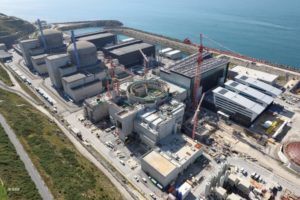Another EPR, or time for something new?
New nuclear Uncategorized 5th February 2016
LWR’s where built en masse in the 70s and 80s, what kind of reactor are we likely to see in a nuclear renaissance?
We are currently in the third generation of nuclear power stations. These power stations boast increased thermal efficiency, improved fuel technology and standardized designs compared to the generation II reactors currently operating in the UK. The European Pressurised Reactor (EPR) to be built at Hinkley Point C improves on proven technologies of the previous generation of LWRs rather than revolutionary new designs. This is not necessarily a bad thing. Over the lifetime of a nuclear power station (60+ years for generation III reactors), technologies are likely to become outdated. Iteratively improving a successful design may seem a good option, but this is not always the case. In France, the Flamanville EPR is taking at least 10 years to construct, with costs tripling from the original estimate due to technical issues and changing safety regulations. So maybe it’s time for something different?

Generation IV reactors are currently under development, and they promise a more diverse range of designs and applications. For example, small modular reactors (SMR’s), believed to help plug an energy gap and a real opportunity for the British economy (through I.P and export). Non-proliferating fast reactors can close the fuel cycle, recycling the actinide waste products for further electricity generation, thereby reducing long-lifetime waste. 4 of the 6 designs being considered can also generate hydrogen as a by-product. Unfortunately, generation IV reactors would not be commercially deployed until 2030-2040 at the very earliest. This leaves a deficit in the UK’s electricity generation over the next 20 years that would have to be filled by other, most likely carbon generating, energy sources.
On balance, it appears that the right decision is not waiting for generation IV reactors. The unpredictability of future energy requirements and the demands for cleaner electricity in the very near future mean that well established reactor designs like LWRs are the only choice left, for now at least.
Tom Neill is a Ph.D. researcher at The University of Manchester.




I totally agree that it seems infeasible for the UK to rely on the implementation of GenIV reactors at this time. However, the installation of LWRs also raises the question of whether it is right for the UK to be leaning towards an open fuel cycle (with the planned closure of THORP in 2018). The uncertainty of future energy supplies and the capability of LWRs or GenIV reactors to burn MOX fuel (and minor actinides), suggests that opportunities will be missed for creating a sustainable fuel cycle if the UK does not establish a defined plan for spent fuel.
Great read, Tom!